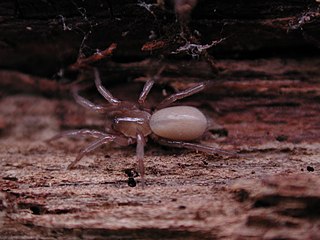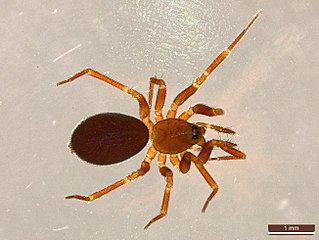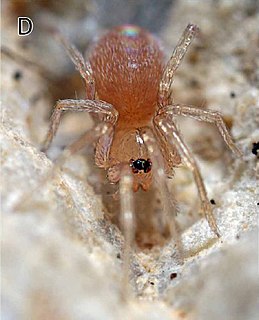
Agelenopsis, commonly known as the American grass spiders, is genus of funnel weavers first described by C. G. Giebel in 1869. They weave sheet webs that have a funnel shelter on one edge. The web is not sticky, but these spiders make up for that shortcoming by running very rapidly. The larger specimens can grow to about 19 mm in body length. They may be recognized by the arrangement of their eight eyes into three rows. The top row has two eyes, the middle row has four eyes, and the bottom row has two eyes. They have two prominent hind spinnerets, somewhat indistinct bands on their legs, and two dark bands running down either side of the cephalothorax.

Cybaeidae is a family of spiders first described by Nathan Banks in 1892. The diving bell spider or water spider Argyroneta aquatica is currently included in this family, though it may soon be moved to Dictynidae.

Callobius is a genus of tangled nest spiders first described by R. V. Chamberlin in 1947.

Kukulcania is a genus of crevice weavers that was first described by Pekka T. Lehtinen in 1967. It is named after Kukulkan, a Mesoamerican serpent deity.
Vaine Wilton Ivie was an American arachnologist, who described hundreds of new species and many new genera of spiders, both under his own name and in collaboration with Ralph Vary Chamberlin. He was employed by the American Museum of Natural History in New York. He also was a supporter of the Technocracy movement.

Metepeira is a genus of orb-weaver spiders first described by F. O. Pickard-Cambridge in 1903. The name is derived from the Ancient Greek μετά and the obsolete genus name Epeira, denoting a genus similar to Epeira.

Cicurina, also called the cave meshweaver, is a genus of dwarf sheet spiders that was first described by Anton Menge in 1871. Originally placed with the funnel weavers, it was moved to the Dictynidae in 1967, then to the Hahniidae in 2017. The name is from the Latin root "cucur-", meaning "to tame".
Spirembolus is a genus of North American sheet weavers that was first described by Ralph Vary Chamberlin in 1920.
Phrurolithidae is a family of araneomorph spiders first described by N. Banks in 1982. First included in the Corinnidae as the subfamily Phrurolithinae, later phylogenetic studies justified a separate family.
Ceratinopsis is a genus of dwarf spiders that was first described by James Henry Emerton in 1882.
Calilena is a genus of North American funnel weavers first described by R. V. Chamberlin & Wilton Ivie in 1941.

Hololena is a genus of North American funnel weavers first described by R. V. Chamberlin & Willis J. Gertsch in 1929.
Rualena is a genus of North American funnel weavers first described by R. V. Chamberlin & Wilton Ivie in 1942.
Calymmaria is a genus of North American araneomorph spiders in the Cybaeidae family, and was first described by R. V. Chamberlin & Wilton Ivie in 1937. They have body lengths ranging from 2 to 10 millimetres.
Eulaira is a genus of North American dwarf spiders that was first described by Ralph Vary Chamberlin & Vaine Wilton Ivie in 1933.
Linyphantes is a genus of North American dwarf spiders that was first described by Ralph Vary Chamberlin & Vaine Wilton Ivie in 1942.

Microneta is a genus of dwarf spiders that was first described by Anton Menge in 1869.
Tachygyna is a genus of North American sheet weavers that was first described by Ralph Vary Chamberlin & Vaine Wilton Ivie in 1939.
Drassinella is a genus of North American araneomorph spiders in the Phrurolithidae family, first described by Nathan Banks in 1904.
Piabuna is a genus of North American araneomorph spiders first described by R. V. Chamberlin & Wilton Ivie in 1933. Originally added to the Liocranidae, it was moved to the Corinnidae in 2002, then to the Phrurolithidae in 2014.









